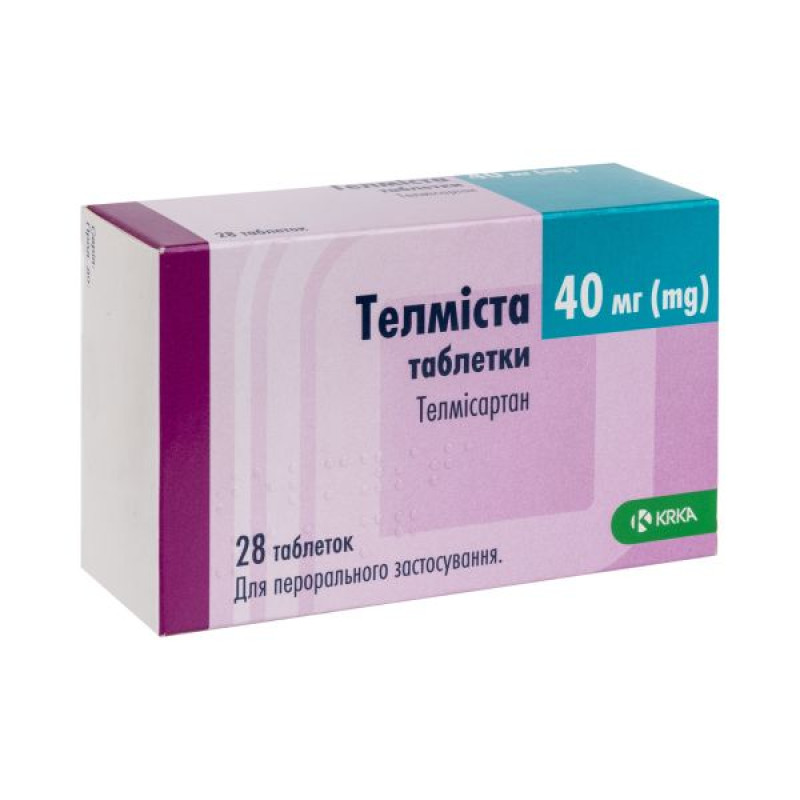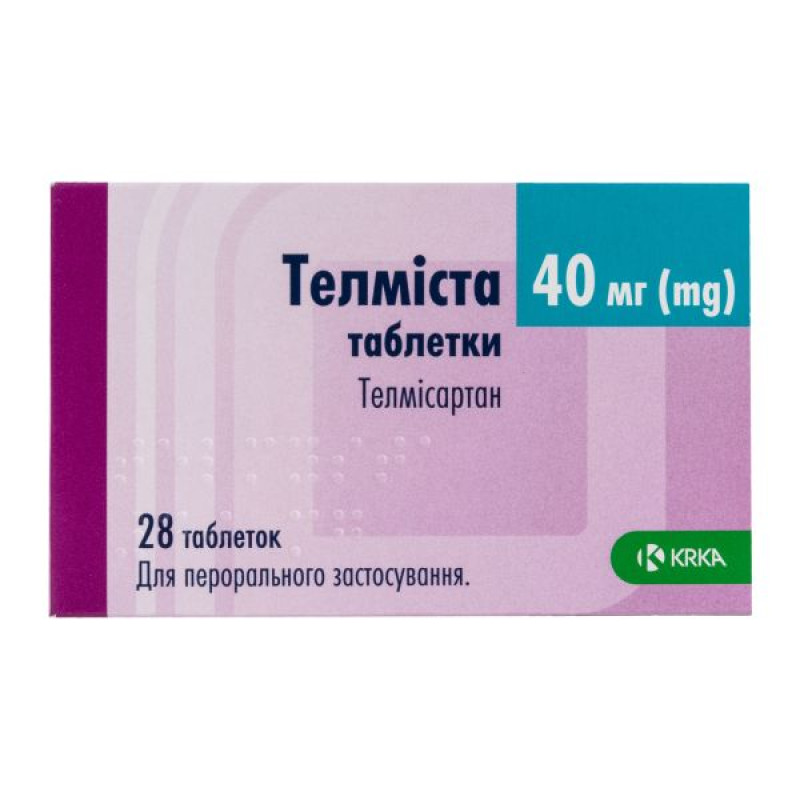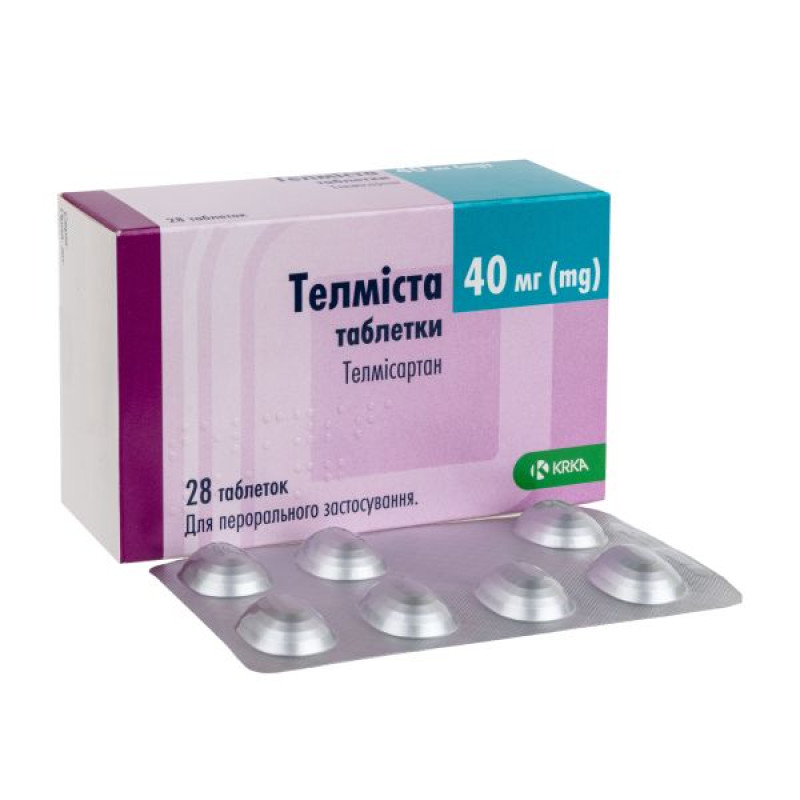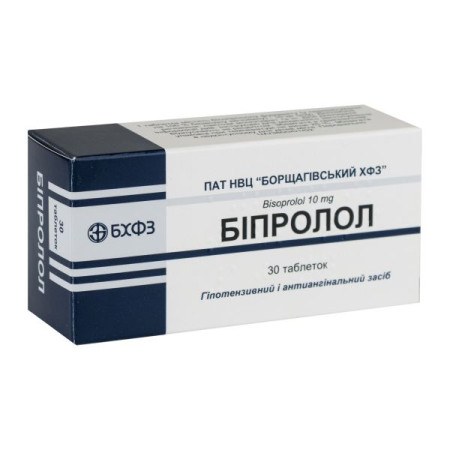Telmista tablets 40 mg blister No. 28

Instructions for Telmista tablets 40 mg blister No. 28
Composition
active ingredient: telmisartan;
1 tablet contains 40 mg of telmisartan;
Excipients: povidone, meglumine, sodium hydroxide, lactose monohydrate, sorbitol (E 420), magnesium stearate.
Dosage form
Pills.
Main physicochemical properties: oval biconvex tablets from white to almost white in color.
Pharmacotherapeutic group
Simple angiotensin II antagonist drugs.
ATX code C09C A07.
Pharmacological properties
Pharmacodynamics
Mechanism of action
Telmisartan is a specific and effective angiotensin II receptor (type AT1) antagonist for oral administration. Telmisartan displaces angiotensin II with very high affinity at its binding sites on the AT1 receptor subtype, which is responsible for the activity of angiotensin II. Telmisartan does not have any partial agonist effect on the AT1 receptor. Telmisartan binds selectively to the AT1 receptor. The binding is long-lasting. Telmisartan has no affinity for other receptors, including AT2 and other, less studied AT receptors. The functional role of these receptors is unknown, as is the effect of their possible "overstimulation" by angiotensin II, the level of which increases under the influence of telmisartan. Telmisartan reduces plasma aldosterone levels. Telmisartan does not reduce plasma renin levels or block ion channels. Telmisartan does not inhibit angiotensin-converting enzyme (kininase II), an enzyme that also degrades bradykinin. Therefore, an increase in bradykinin-related side effects should not be expected.
In humans, telmisartan at a dose of 80 mg almost completely inhibits the increase in blood pressure caused by angiotensin II. The blocking effect is maintained for 24 hours and remains significant for up to 48 hours.
Clinical efficacy and safety
Treatment of arterial hypertension
After the first dose of telmisartan, antihypertensive activity gradually develops within 3 hours. The maximum reduction in blood pressure is achieved 4-8 weeks after the start of treatment and is maintained during long-term therapy.
The antihypertensive effect is maintained continuously for 24 hours after administration, including the last 4 hours before the next dose, as determined by ambulatory blood pressure monitoring. This is confirmed by the ratio of telmisartan concentration before the next dose to Cmax, which is 80% after taking 40 and 80 mg of telmisartan in placebo-controlled clinical trials. A dose-dependent trend for time to recovery to baseline systolic blood pressure is expected. In this regard, data on diastolic blood pressure are inconsistent.
In patients with hypertension, telmisartan reduces both systolic and diastolic blood pressure without affecting pulse rate. The addition of the diuretic and natriuretic effects of the drug to the hypotensive effect remains to be determined. The antihypertensive efficacy of telmisartan is consistent with that of other classes of antihypertensive drugs (as demonstrated in clinical trials comparing telmisartan with amlodipine, atenolol, enalapril, hydrochlorothiazide and lisinopril).
If treatment with telmisartan is abruptly discontinued, blood pressure gradually returns to pre-treatment values within a few days without the likelihood of withdrawal syndrome.
In direct comparison clinical trials, the incidence of dry cough was significantly lower in patients taking telmisartan than in those taking ACE inhibitors.
Prevention of cardiovascular diseases
The ONTARGET study (Telmisartan and Ramipril Treatment Study) compared the effects of telmisartan, ramipril, and their combination on cardiovascular outcomes in 25,620 patients aged 55 years and older with a history of cardiovascular disease, stroke, obliterating endarteritis, or diabetes mellitus with evidence of target organ damage (e.g., retinopathy, left ventricular hypertrophy, macro- or microalbuminuria), i.e. a broad spectrum of patients at cardiovascular risk.
Patients were randomized to one of three treatment groups: telmisartan 80 mg, ramipril 10 mg, or a combination of telmisartan 80 mg and ramipril 10 mg, after which patients were followed for an average of 4.5 years.
Telmisartan was as effective as ramipril in reducing the primary endpoint. The incidence of the primary endpoint was similar in the telmisartan (16.7%), ramipril (16.5%), and telmisartan and ramipril combination groups (16.3%). The multivariate hazard ratio for telmisartan compared with ramipril was 1.01 (97.5% CI 0.93–1.10, p (non-inferiority) = 0.0019).
Telmisartan was also found to be as effective as ramipril in several specified secondary endpoints, including a composite of cardiovascular death, non-fatal myocardial infarction, non-fatal stroke, or hospitalization for congestive heart failure, the primary endpoint of the controlled HOPE trial. HOPE compared ramipril with placebo. The relative risk of telmisartan versus ramipril for this endpoint in ONTARGET was 0.99 (97.5% CI 0.90–1.08, p (non-inferiority) = 0.0004).
Cough and angioedema were reported less frequently in patients taking telmisartan than in patients taking ramipril, although hypotension was reported more frequently with telmisartan.
The combination of telmisartan and ramipril did not provide a better effect compared to ramipril or telmisartan used alone. In addition, a significantly higher incidence of hyperkalemia, renal failure, hypotension and dizziness was recorded in the combination treatment group. Therefore, the combination of telmisartan and ramipril is not recommended for this group of patients.
Pharmacokinetics
Absorption
Absorption of telmisartan is rapid, although the amounts absorbed vary. The mean absolute bioavailability of telmisartan is approximately 50%. When telmisartan is taken with food, the decrease in AUC0-∞ for telmisartan ranges from approximately 6% (40 mg dose) to approximately 19% (160 mg dose). Three hours after dosing, plasma concentrations are similar whether telmisartan is taken on an empty stomach or with food.
Linearity/nonlinearity
The small decrease in AUC is not expected to result in a decrease in therapeutic efficacy. There is no linear relationship between doses and plasma levels. Cmax and AUC increase disproportionately with dose at doses above 40 mg.
Distribution
Telmisartan is extensively bound to plasma proteins (> 99.5%), mainly to albumin and alpha-1 acid glycoprotein. The mean apparent volume of distribution at steady state (Vdss) is approximately 500 l.
Metabolism
Telmisartan is metabolized by conjugation with the glucuronide of the parent compound. The pharmacological activity of the conjugate has not been established.
Breeding
Telmisartan is characterized by a biexponential pharmacokinetic curve with a terminal half-life of > 20 hours. Cmax and AUC increase disproportionately with dose. There is no evidence of clinically significant accumulation of telmisartan when used at recommended doses. Plasma concentrations were higher in women than in men, without a corresponding effect on efficacy.
After oral administration, telmisartan is almost completely excreted in the faeces, mainly as unchanged compound. Cumulative renal excretion is < 1% of the dose. Total plasma clearance (Cltot) is high (approximately 1000 ml/min) compared to hepatic blood flow (approximately 1500 ml/min).
Special patient groups
Sex
A difference in plasma concentrations was observed, with Cmax and AUC being approximately 3- and 2-fold higher in women than in men, respectively.
Elderly patients
The pharmacokinetics of telmisartan are similar in patients under 65 years of age and in elderly patients.
Patients with renal impairment
In patients with mild, moderate and severe renal impairment, plasma concentrations were doubled. However, in patients with renal failure undergoing dialysis, low plasma concentrations were observed. Telmisartan is highly bound to plasma proteins in subjects with renal failure and cannot be removed by dialysis. The elimination half-life is not altered in patients with renal impairment.
Patients with hepatic impairment
Pharmacokinetic studies in patients with hepatic impairment have shown an increase in absolute bioavailability to approximately 100%. The elimination half-life is not altered in patients with hepatic impairment.
Indication
Hypertension.
Treatment of essential hypertension in adults.
Prevention of cardiovascular diseases.
Reducing the incidence of cardiovascular disease in patients with:
manifest atherothrombotic cardiovascular disease (history of ischemic heart disease, stroke, or peripheral arterial disease); type 2 diabetes mellitus with documented target organ damage.
Contraindication
Hypersensitivity to the components of the drug; pregnant women or women planning to become pregnant (see section "Use during pregnancy or breastfeeding"); obstructive biliary disorders; severe liver dysfunction.
The concomitant use of telmisartan and aliskiren in patients with diabetes mellitus or renal impairment (GFR < 60 ml/min/1.73 m2) is contraindicated (see sections “Method of administration and dosage”, “Special precautions for use”, “Interaction with other medicinal products and other types of interactions”).
Interaction with other medicinal products and other types of interactions
The combination of telmisartan and aliskiren is contraindicated in patients with diabetes mellitus and renal impairment (GFR < 60 ml/min/1.73 m2) and is not recommended for other patients (see sections "Contraindications", "Special warnings and precautions for use").
Digoxin
When telmisartan and digoxin were co-administered, mean increases in peak plasma digoxin concentrations (by 49%) and trough concentrations (by 20%) were observed. Digoxin levels should be monitored at the start of treatment, when the dose is adjusted and when telmisartan is discontinued to maintain them within the therapeutic range.
As with other drugs that inhibit the renin-angiotensin system, telmisartan may induce hyperkalemia (see section 4.4). The risk may be increased by concomitant treatment with other drugs that may also induce hyperkalemia (salt substitutes containing potassium, potassium-sparing diuretics, angiotensin-converting enzyme inhibitors, angiotensin II receptor antagonists, non-steroidal anti-inflammatory drugs (NSAIDs, including selective COX-2 inhibitors), heparin, immunosuppressants (ciclosporin or tacrolimus) and trimethoprim).
The incidence of hyperkalemia depends on the associated risk factors. The risk increases with the above therapeutic combinations. The risk is particularly high in combination with potassium-sparing diuretics and in combination with potassium-containing salt substitutes. The combination with ACE inhibitors or NSAIDs, for example, is less risky if the precautions for use are strictly observed.
Concomitant use is not recommended.
Potassium-sparing diuretics or potassium supplements. Angiotensin II receptor antagonists such as telmisartan attenuate diuretic-induced potassium loss. Potassium-sparing diuretics such as spironolactone, eplerenone, triamterene or amiloride, potassium supplements or potassium-containing salt substitutes may lead to significant increases in serum potassium. If concomitant use is indicated because of documented hypokalaemia, they should be used with caution, with frequent monitoring of serum potassium.
Lithium: Reversible increases in serum lithium concentrations and toxicity have been reported during concomitant administration of lithium with angiotensin-converting enzyme inhibitors and angiotensin II receptor antagonists, including telmisartan. If the combination is considered necessary, serum lithium levels should be closely monitored during concomitant use.
Concomitant use requires caution.
Nonsteroidal anti-inflammatory drugs: NSAIDs (i.e. acetylsalicylic acid at anti-inflammatory doses, COX-2 inhibitors and non-selective NSAIDs) may reduce the antihypertensive effect of angiotensin II receptor antagonists.
In some patients with compromised renal function (e.g. dehydrated patients or elderly patients with compromised renal function), the combination of angiotensin II receptor antagonists and cyclooxygenase inhibitors may lead to further deterioration of renal function, including possible acute renal failure, which is usually reversible. Therefore, this combination should be administered with caution, especially in the elderly. Patients should be adequately hydrated; in addition, renal function should be monitored after initiation of combination therapy and periodically thereafter.
In one study, it was reported that the combined administration of telmisartan and ramipril resulted in a 2.5-fold increase in AUC0-24 and Cmax of ramipril and ramiprilat. The clinical significance of this observation is unknown.
Diuretics (thiazide or loop diuretics): Pre-treatment with high doses of diuretics such as furosemide (loop diuretic) and hydrochlorothiazide (thiazide diuretic) may lead to volume depletion and a risk of hypotension at the start of treatment with telmisartan.
This should be taken into account when used concomitantly.
Other antihypertensive agents: The blood pressure-lowering effect of telmisartan may be enhanced by concomitant use of other antihypertensive agents.
Based on the pharmacological properties of baclofen and amifostine, it can be expected that these drugs may potentiate the hypotensive effect of all antihypertensive drugs including telmisartan. In addition, alcohol, barbiturates, narcotics or antidepressants may exacerbate orthostatic hypotension.
Corticosteroids (systemic use). Decreased antihypertensive effect.
Application features
Hepatic impairment: Telmisartan should not be administered to patients with cholestasis, obstructive bile duct disease and severe hepatic impairment (see section 4.3) as telmisartan is excreted primarily in the bile. In such patients, a reduction in hepatic clearance of telmisartan can be expected.
Telmisartan should be administered with caution to patients with mild to moderate hepatic impairment.
Renovascular hypertension: There is an increased risk of severe hypotension and renal failure when patients with bilateral renal artery stenosis or stenosis of the artery to a solitary kidney are treated with drugs that affect the renin-angiotensin-aldosterone system.
Renal impairment and kidney transplantation: If Telmisartan is prescribed to patients with impaired renal function, periodic monitoring of serum potassium and creatinine is recommended. There is no experience with the use of Telmisartan in patients with a recent kidney transplantation.
Volume depletion. Symptomatic hypotension, especially after the first dose of Telmisartan, may occur in patients who are volume and/or sodium depleted by vigorous diuretic therapy, dietary salt restriction, or diarrhea and vomiting. These conditions should be corrected before starting Telmisartan. Sodium and volume depletion should be corrected before starting treatment with Telmisartan.
Dual blockade of the renin-angiotensin-aldosterone system.
The use of telmisartan in combination with aliskiren in patients with diabetes mellitus or renal impairment (GFR < 60 ml/min/1.73 m2) is contraindicated (see section "Contraindications").
There is evidence that the concomitant use of ACE inhibitors, angiotensin II receptor blockers or aliskiren increases the risk of hypotension, hyperkalaemia and decreased renal function (including acute renal failure). Therefore, dual blockade of the renin-angiotensin-aldosterone system through the concomitant use of ACE inhibitors, angiotensin II receptor blockers or aliskiren is not recommended (see sections 4.5 and 5.1).
If dual blockade therapy is considered absolutely necessary, it should only be administered under specialist supervision and with frequent, careful monitoring of renal function, electrolytes and blood pressure.
ACE inhibitors and angiotensin II receptor blockers should not be used concomitantly in patients with diabetic nephropathy.
Other conditions requiring stimulation of the renin-angiotensin-aldosterone system.
In patients whose vascular tone and renal function depend predominantly on the activity of the renin-angiotensin-aldosterone system (e.g. patients with severe congestive heart failure or severe renal disease, including renal artery stenosis), the use of Telmisartan with other medicinal products that affect the renin-angiotensin-aldosterone system has been associated with acute hypotension, hyperazotemia, oliguria, and rarely acute renal failure (see section 4.8).
Primary hyperaldosteronism: Patients with primary hyperaldosteronism generally do not respond to antihypertensive drugs that act by blocking the renin-angiotensin system. Therefore, the use of telmisartan in these patients is not recommended.
Aortic and mitral valve stenosis, obstructive hypertrophic cardiomyopathy. As with other vasodilators, the drug should be prescribed with extreme caution to patients diagnosed with aortic or mitral valve stenosis or obstructive hypertrophic cardiomyopathy.
Diabetic patients treated with insulin or antidiabetic drugs.
Hypoglycemia may develop in such patients during treatment with telmisartan. Appropriate blood glucose monitoring should be considered in such patients. Dosage adjustment of insulin or antidiabetic medicinal products may be required.
In patients with diabetes mellitus at cardiovascular risk (diabetic patients with concomitant coronary artery disease), the risk of fatal myocardial infarction and sudden cardiovascular death may be increased when treated with antihypertensive drugs such as angiotensin II receptor antagonists and ACE inhibitors. In patients with diabetes mellitus, concomitant coronary artery disease may be asymptomatic and therefore undiagnosed. Patients with diabetes mellitus should be carefully evaluated, e.g. by stress testing, to identify and treat concomitant coronary artery disease before prescribing the drug.
Hyperkalemia: Hyperkalemia may occur during the entire course of treatment with drugs that affect the renin-angiotensin-aldosterone system.
Before considering the concomitant use of medicinal products that inhibit the renin-angiotensin system, the benefit-risk ratio should be weighed.
The main risk factors for developing hyperkalemia that you need to pay attention to are:
diabetes mellitus, renal insufficiency, age (over 70 years); combination therapy with one or more other drugs that affect the renin-angiotensin system and/or potassium supplements. Drugs or therapeutic classes of drugs that may induce hyperkalemia include salt substitutes containing potassium, potassium-sparing diuretics, angiotensin-converting enzyme inhibitors, angiotensin II receptor antagonists, nonsteroidal anti-inflammatory drugs (NSAIDs, including selective COX-2 inhibitors), heparin, immunosuppressants (cyclosporine or tacrolimus) and trimethoprim; concomitant diseases, especially dehydration, acute cardiac decompensation, metabolic acidosis, deterioration of renal function, acute deterioration of renal condition (e.g. infectious diseases), cellular lysis (e.g. acute limb ischemia, rhabdomyolysis, extensive trauma).
Patients at risk should undergo careful monitoring of serum potassium concentrations (see section “Interaction with other medicinal products and other types of interactions”).
Sorbitol: This medicinal product contains sorbitol (E 420). Patients with rare hereditary problems of fructose intolerance should not take this medicinal product.
Lactose
Telmisartan contains lactose, therefore patients with rare hereditary problems of galactose intolerance, the Lapp lactase deficiency or glucose-galactose malabsorption should not take this medicine.
Ethnic differences: As with all angiotensin II receptor antagonists, telmisartan is apparently less effective in lowering blood pressure in black patients than in non-blacks. This may be due to a higher prevalence of low-renin states in black hypertensive patients.
Others: As with any other antihypertensive agent, a significant decrease in blood pressure in patients with ischemic cardiopathy or ischemic cardiovascular disease may lead to myocardial infarction or stroke.
Ability to influence reaction speed when driving vehicles or other mechanisms
When driving a car or operating machinery, it is necessary to take into account the possibility of dizziness or hypersomnia during antihypertensive therapy, including Telmista.
Use during pregnancy or breastfeeding
Pregnancy.
The drug is contraindicated for use in pregnant women or women planning to become pregnant. If pregnancy is confirmed during treatment with this drug, its use should be discontinued immediately and, if necessary, replaced with another drug approved for use in pregnant women.
Breast-feeding.
Because no information is available regarding the use of Telmisartan during breast-feeding, this medicine is not recommended. Alternative treatments with better established safety profiles during breast-feeding are preferable, especially while nursing a newborn or preterm infant.
Fertility.
In preclinical studies, no effect of Telmisartan on male or female fertility was observed.
Method of administration and doses
Treatment of arterial hypertension.
The usual effective dose is 40 mg daily. Some patients may find a daily dose of 20 mg sufficient. If the desired blood pressure is not achieved, the dose of telmisartan can be increased to 80 mg once daily. Alternatively, telmisartan can be given in combination with thiazide diuretics, such as hydrochlorothiazide, which has been shown to provide additional blood pressure lowering when used with telmisartan. When considering increasing the dose, it should be borne in mind that the maximum antihypertensive effect is generally achieved 4 to 8 weeks after initiation of treatment.
Prevention of cardiovascular diseases.
The recommended dose is 80 mg once daily. The efficacy of telmisartan at doses below 80 mg in the prevention of cardiovascular disease is unknown.
When starting treatment with telmisartan for the prevention of cardiovascular diseases, it is recommended to monitor blood pressure and, if necessary, adjust the dose of drugs that lower blood pressure.
Special patient groups
Renal impairment. Experience in patients with renal insufficiency or patients undergoing hemodialysis is limited. In such patients, it is recommended to start treatment with a low dose of 20 mg (see section "Special instructions"). No dose adjustment is required for patients with mild to moderate renal insufficiency.
The concomitant use of telmisartan and aliskiren in patients with diabetes mellitus or renal impairment (GFR < 60 ml/min/1.73 m2) is contraindicated (see section "Contraindications").
Hepatic impairment: Telmisartan is contraindicated in patients with severe hepatic impairment.
Elderly patients: No dose adjustment is required for elderly patients.
Method of application.
Telmisartan is taken orally once a day with sufficient liquid, with or without food.
Children
Telmisartan is not recommended for use in children under 18 years of age due to insufficient data on safety and efficacy.
Overdose
Only limited information is available on overdose in humans.
Symptoms
The most significant manifestations of telmisartan overdose were hypotension and tachycardia; bradycardia, dizziness, increased serum creatinine and acute renal failure have also been reported.
Treatment
Telmisartan is not removed by haemodialysis. In the event of overdose, the patient should be closely monitored and symptomatic and supportive therapy should be administered. The choice of treatment depends on the time elapsed since administration and the severity of symptoms. Measures such as induction of emesis and/or gastric lavage should be considered. Activated charcoal may be useful in the treatment of overdose. Serum electrolytes and creatinine levels should be monitored frequently. If hypotension occurs, the patient should be placed in the supine position and salt substitutes and volume should be rapidly administered.
Adverse reactions
Serious adverse reactions, including anaphylactic reaction and angioedema, may occur in isolated cases (≥ 1/10,000 to < 1/1,000), and acute renal failure has also been observed.
The overall incidence of adverse events in patients with hypertension in controlled clinical trials with telmisartan was generally comparable to that with placebo (41.4% versus 43.9%). The incidence of adverse events was not dose-related and did not correlate with gender, age, or race. The safety profile of Telmisartan in the prevention of cardiovascular disease was consistent with that in the treatment of hypertension.
Adverse reactions are listed under headings of frequency using the following convention: very common (≥1/10); common (≥1/100 to <1/10); uncommon (≥1/1,000 to <1/100); rare (≥1/10,000 to <1/1,000); very rare (<1/10,000).
Within each group, side effects are listed in order of decreasing severity.
Infections and infestations:
uncommon – urinary tract infections, including cystitis, upper respiratory tract infections, including pharyngitis and sinusitis;
rarely – sepsis, including fatal outcome1.
From the blood and lymphatic system:
infrequently - anemia;
rarely - eosinophilia, thrombocytopenia.
On the part of the immune system:
rarely - anaphylactic reaction, hypersensitivity.
Metabolic disorders:
infrequently - hyperkalemia;
rarely - hypoglycemia (in patients with diabetes).
Mental disorders:
infrequently - insomnia, depression;
rarely - anxiety.
From the nervous system:
infrequently – syncope;
rarely - drowsiness.
On the part of the organs of vision:
rarely - visual impairment.
From the side of the organs of hearing, vestibular apparatus:
infrequently - vertigo.
From the heart:
infrequently – bradycardia;
rarely - tachycardia.
From the vascular side:
uncommon – arterial hypotension2, orthostatic hypotension.
From the respiratory system, chest organs and mediastinum:
infrequently - dyspnoea, cough;
very rarely – interstitial lung disease4.
From the digestive tract:
infrequently - abdominal pain, diarrhea, dyspepsia, flatulence, vomiting;
rarely - dry mouth, discomfort in the stomach area.
Hepatobiliary disorders:
Rare: liver dysfunction/hepatic disorders3.
From the skin and subcutaneous tissue:
infrequently - itching, increased sweating, rash;
rarely - angioedema (including fatal), eczema, erythema, urticaria, drug dermatitis, toxic dermatitis.
Musculoskeletal and connective tissue disorders:
infrequently - back pain (e.g. sciatica), muscle cramps, myalgia;
rarely - arthralgia, pain in the extremities, tendon pain (symptoms similar to tendinitis).
From the urinary system:
uncommon - renal dysfunction, including acute renal failure.
General violations:
infrequently - chest pain, asthenia (weakness);
rarely - flu-like symptoms.
Laboratory data:
infrequently - increased creatinine in the blood;
rarely - decreased hemoglobin levels, increased uric acid in the blood, increased liver enzymes, increased creatine phosphokinase levels in the blood.
1, 2, 3, 4 - See section "Adverse reactions. Description of selected adverse reactions".
Description of selected adverse reactions
Sepsis: In the PRoFESS trial, a higher rate of sepsis was observed in patients taking telmisartan than in those taking placebo. This may be a coincidence or a sign of a process whose nature is currently unknown.
Hypotension: This adverse reaction was observed commonly in patients with controlled blood pressure who were treated with telmisartan to reduce cardiovascular disease in addition to standard therapy.
Interstitial lung disease: Cases of interstitial lung disease have been observed transiently with the use of telmisartan during post-marketing surveillance. However, a causal relationship has not been established.
Expiration date
3 years.
Storage conditions
Store at a temperature not exceeding 30 °C.
Store in the original packaging to protect from light.
Keep out of reach of children.
Packaging
7 tablets in a blister, 4 blisters in a cardboard box.
Vacation category
According to the recipe.
Producer
"In bulk" production, primary and secondary packaging, control and batch release
KRKA, dd, Novo mesto, Slovenia/KRKA, dd, Novo mesto, Slovenia
KRKA Polska Sp.z oo, Poland
Location of the manufacturer and its business address
Smarjeska cesta 6, 8501 Novo mesto, Slovenia
ul. Rownolegla 5, 02-235 Warsawа, Poland/ul. Rownolegla 5, 02-235 Warsawа, Poland
There are no reviews for this product.
There are no reviews for this product, be the first to leave your review.
No questions about this product, be the first and ask your question.








